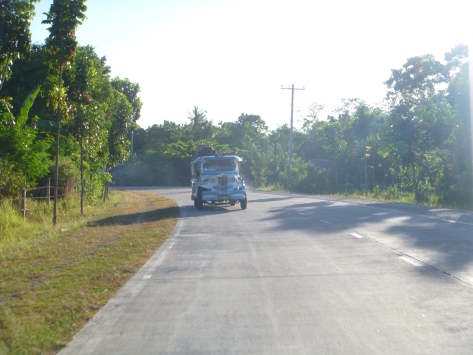Public transportation in the Philippines is somehow genial. Both the cheapest and most uncomfortable way of travel I have experienced so far. Here everything can be turned into a public transport vehicle and the word full is a plain abstraction. In fact in reality there is always a way to fit a couple of more persons within the vehicle and I do mean always! Few persons here have cars and the most typical one is an open truck as our green beast. This popular way of travel is actually my favourite one. It allows you to appreciate the stunning scenery while relaxingly sitting in the back and inevitably get sunburned. The fanciest one also has a personalized tune for reverse gear, my personal favorite is the Lambada tune.
Almost everybody has motorbikes, on which you can bring your entire family, normally 3 to 6 persons. Helmets are not popular and are usually substituted by a long sleeve t-shirt used as a balaclava to protect from sun and dust.
However sometimes you need to bring your grocery with you, generally this involves 1 to 3 yuta bags of 25 kg each of chicken grain food, the same amount of rice, chicken and a scale, in case somebody would like to purchase your products on the way (and it does happen quite often). In this case a jeepny might be a more appropriate way to move. Jeepnies are small buses, personalized with incredible colours and prayers.
The price is usually fixed along a certain road and in order to signal the driver you intention to get off you need a coin. You then need to tap the coin on a metal bar as you would do playing the triangle. The technique should be mastered as it is not as easy as it sounds. Especially difficult for western tourists, is finding the right momentum to effectively tap. In fact there are no set stops and the driver will let you off wherever you desire especially since walking is absolutely not taken into any consideration and you would look like a weirdo to try. However the vehicle would stop every 2 meters to let you off making time and punctuality a western overrated concept that simply doesn’t apply here.
Buses are also effective and they allow wider view of the outskirt. There are two types of buses, air con and non-air con, something I discovered only after I saw Cebu Island since in Bohol I never had the chance to see air con buses. The non-air con buses are way cheaper and recognizable by the open windows. They are generally very windy as there are no glasses. However in case of rain you should not despair, in fact wooden panel can be pulled up from a cut on the side. When all the wooden panels are pulled up the bus becomes very cosy and extremely smelly.
As for any other transports in the Philippines, on buses you quickly get accustomed to a complete lack of personal space and a seat for one can be shared with up to 5 persons. You need to hope for skinny people. Otherwise there is always the option of sitting on the roof.
Air con buses may be compared to a colourful refrigerator cell. Painfully cold these buses are not necessarily more comfortable as people are stored in the central row as well, thanks to wooden bench normally stored underneath the seats.
If you prefer a more private transportation you may take a tricycle. Differently from risho, tricycles are motorized and comes in various shape and dimension. In Jagna very are similar to tiny jeepnies with up to a 6 persons capacity while in Tagbilaran are smaller and resemble ice cream carts. Tricycles are more expensive and not necessarily faster or more comfortable but are able to go on every road, luxury that might be not shared with buses or jeepnies.
Every public transports shares the same driving style. There are simply no rules, no speed limits and no security concerns. However drivers have an unwritten honk code that, unfortunately, I wasn’t able to decipher. Some of my theories are: honk when there is something or somebody on the road; honk twice if you don’t see what’s after the turn. Honk to cheer and honk to communicate with fellow drivers.
Another shared feature of public transport are God’s quotes and prayers that can be found into and onto each vehicle. However while in Tagbilaran is common to find Bible extract and Christians suggestions, as “pray the holy rosary daily”, in Cebu city and Manila vehicle are less dictators and more inquisitive. Thus on the back of cars, taxis and jeepnies you may be asked to provide comments on the driving style by calling or texting a certain number.
Whatever your transport choice may be, public or private, you have the tranquillity and serenity of knowing that if a tyre will blow, one of the ten thousands vulcanizing shops along the road might be able to fix it.
In Bohol, there are millions of them, however in Cebu you may find one only every 100m so plan your trip accordingly.








